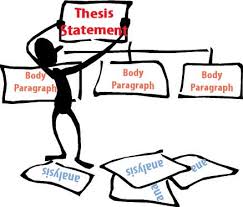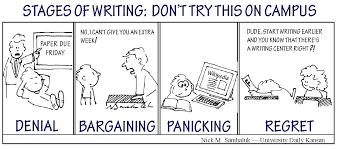If you follow these instructions, you will be able to finish your research paper in one day. (You might have to go to a library for peace. Add half a day if you have done no research yet. Some teachers provide example papers. I know I do! When using a library database, try to restrict yourself to newspapers and magazines because they are easier to digest.)
* Put the prompt at the top of the paper while you are working on it.
* Make sure you have a working thesis statement to begin with (that addresses the prompt at the top of the paper).
* Each paragraph following the introduction should (theoretically) have a topic sentence (the first sentence) that will introduce an idea that supports the working thesis (which can be your definitive thesis statement if you are happy with it).
Ways to get ideas for body paragraphs:
- Give background of issue or individuals or groups
- Define (explain) terms or issues
- Talk about why your thesis is correct
- Give the opposing point of view and then explain why it is incorrect or not viable (argument strategy).
- If your issue depends on historical chronology, try to stick to it so you do not confuse a reader who has never read about this problem before.
6. Itemize the reasons for or the problems brought on by the issue you are discussion (cause/effect strategy).
7. Enumerate the subsections of the issue you have to write about (classification strategy).
Ways to find more ideas to develop the research essay:
- From your text book readings, if that is where the prompt comes from and you are allowed to use that reading as a source, find a line (quote) that you like. Take it as the main idea of a paragraph, introducing it with your own observation (try not to begin a paragraph with a quotation from someone as it is much better to state a problem and follow with the writer’s observation). Then you can enlarge upon what the author said, making it relevant to the modern reader.
- Look at example papers (In my classes, I provide examples from students in previous semesters). If you like something someone said, you can use the idea so long as you do not steal it word for word. Look at that writer’s sources and if he or she is directly referring to a newspaper or magazine article, find it and look at it. You might discover a new idea or another line you want to quote that can enrich your essay.
- Read what you have out loud to yourself or someone else or a tape recorder. Read slowly. If you record it, don’t listen to it immediately. Go take a walk or have lunch to clear your head.
- Last but not least: the more articles you read (newspapers or popular magazines are easiest to comprehend!), the more ideas you will get.
- Write about what you understand best. Don’t worry about the parts you don’t understand if you feel you have tried very hard to understand. Some of us feel most comfortable writing about armaments, some about political personalities, government, foreign policy, and so on. Write about what you understand!
- You have the right to talk about mistakes of people or governments that no one has talked about. For instance, one student mentioned to me yesterday that she felt very disappointed the Benazir Bhutto did not use a bulletproof shield when she went into the street on the day she was killed. What a great observation! The student felt that Bhutto’s courage was eclipsed by her foolhardiness. Students have the right to make those observations! We teachers love that. : )
The last edit:
* The last edit is always reserved for spelling and punctuation.
* Don’t use “you.”
* I allow my writers to use first person, “I” or “we.” In other classes, you must consult your teacher first about whether first person is allowed.
* Look for vague words like “it,” “this” and “that” in your research essay. If you have printed the paper out (a really good idea), circle each “it,” “this” and “that” and then make sure it is clear. Try reading those parts to someone else and then ask the listener, “What did I mean by ‘it’?”
“That” is sometimes used to begin a clause. Sometimes you can take “that” out and the sentence still reads fine. Try it. Here is an example: “I told him that I could not come today.” Revised: “I told him I could not come today.” (That is invisibly still there!)
* Concrete nouns work so much better than vague words.
* Double check your possessive pronouns (his, her, their) to make sure they correspond with the word they are referring to. (“If a child is sick, take him or her to the doctor” (not “If a child is sick, take them to the doctor.”)
* Double check your pronouns in general (he, she, they) to make sure they correspond in number to the word they are referring to.
*On that subject, remember that a country is a collective noun, usually referred to in the singular: “Mexico refused to sell its territories” and “The United States had its own interests at heart.” Yes, even the United States is generally thought of as singular when we write about it. It takes action as a collective unit.
* Collective nouns become plural ONLY when they have to for the sake of logic: “The jury have put on their coats and gotten in their cars to go home.”
* If you have an apostrophe addiction, make sure every single ‘s in your paper is for a possessive: The president’s idea (the idea belonged to the president). We do not create plural words with ‘s. Americans, when referring to the people living on the American continent or the USA, is written without an apostrophe.
* At the end of the paper, click on insert>page break so that your Works Cited is on its own page.
* Make sure all the entries on your Works Cited page are in alphabetical order.
* Block all your entries on the Works Cited page and then click on Home> paragraph (go to the lower right hand box and click on that, and it will open up another box)>indent (choose “hanging”).

